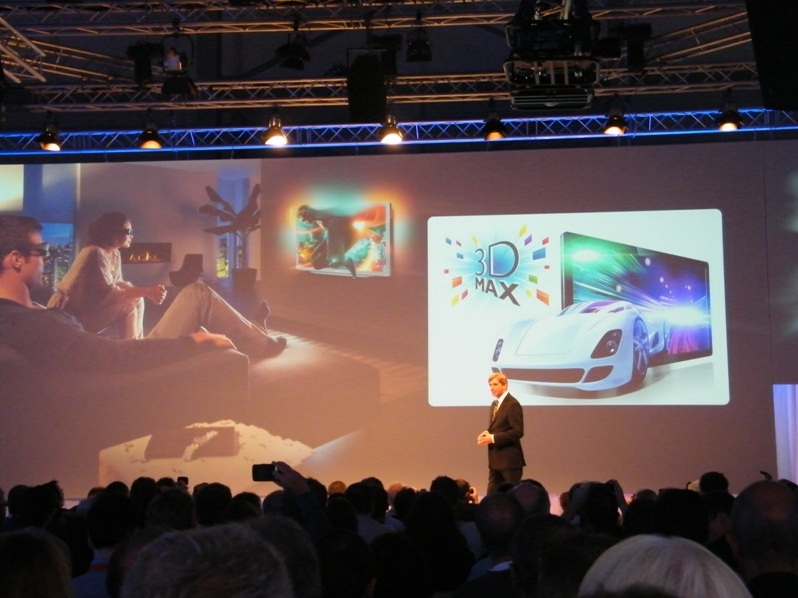Philips launches worlds' fastest TVs
And a 15,000,000:1 contrast ratio donated by moths

Twelve months ago at IFA each major press conferences came and went with a unified message: 3D, 3D, 3D, 3D, 3D!
It was getting boring even a year before that, and so we literally squeezed into the big Philips press conference today along with hundreds of other international journalists through one impossibly small door, with a feeling of trepidation.
However, we needn't have worried. This year the signs are that the 3D winter is thawing out a bit, with the big news not actually revolving around 3D itself.
And we're not talking about the "biggest innovation in oral healthcare ever seen" either, despite Philips starting its presentation by talking about its new 70MPH toothbrush.
The big new feature is called the Moth Eye filter which dramatically increases the contrast ratio of a TV by eliminating reflections. It's essentially a transparent foil filter which sits in front of the panel and absorbs all incoming light instead of reflecting it back out again.
"The eye of a moth has evolved into an ingenious structure that eliminates almost all reflections," said Philips' Robert Smitts at the press conference. "It's great for the moth, because it stays hidden from predators. It's also great for viewers of our televisions, which now include the moth eye filter which delivers the deepest black and the highest image contrast ratio in the industry."
The upshot of this is that blacks are much deeper - Philips claims it increases contrast ratio by 10 times, resulting in a final number of 15,000,000:1. Yes, that's 15 million to one. We suspect when we actually test it, the number will be significantly below that but make no mistake, this is a big step forward for LCD TVs.
Sign up for breaking news, reviews, opinion, top tech deals, and more.
More moths
The tech was co-developed by Philips with Sharp, who will also be using the Moth Eye filter on its own TVs in the future - but not yet.
In 2011, the moth-inspired innovation will only be available on Philips' new 46PFL9706 TV which has won the EISA award for Best 3D TV at this year's show, but you can bet we'll be sitting here in 12 months time announcing its availability across the 2012 range.
We've seen this TV up close, and can report that contrast really is extraordinary. Even with bright TVs positioned directly in front of the panel, the reflected light is minimal.
The other big TV-related announcements included new 21:9 sets which refresh at 1200Hz and have a response time of just 0.5ms.
"Today we are launching our smartest, fastest cinema-proportion TV ever. Its 0.5ms response time makes it the fastest LED screen in the world today. It delivers super-sharp smooth flowing images even when the action reaches fever-pitch," Smitt enthused.
Game on
The other interesting talking point with the new Philips TVs is the addition of two player full screen gaming. Like the forthcoming Sony PlayStation TV, this feature will allow two gamers to play with each other in full screen, on the same display. Using reversed 3D glasses (the new active 3D glasses have a button to toggle this gaming mode) both players see a different picture.
This is, of course, not in HD or 3D, but was made possible by the technology that was initially developed for 3D.
And finally, Philips has also become the first manufacturer to offer both active and passive 3D TVs.
Philips likes to brand TV features using its own terms (see LED Pro instead of Full LED, for example) and has renamed active 3D to '3D Max' while passive 3D is being called 'Easy 3D'. The names make sense to us, and it shows that there is a market out there for passive 3D.
Philips clearly doesn't want to allow LG to sweep the floor with Passive 3D sales, despite claiming last year that Active 3D was the only way to go.
There is no doubt that these steps forward are merely iterations on top of iterations.
But the fact that we're no longer being bombarded with the 3D message and returning the attention to the ever-improving picture and sound quality issues, as well as increased functionality, is the breath of fresh air we were looking for.

James was part of the TechRadar editorial team for eight years up until 2015 and now works in a senior position for TR's parent company Future. An experienced Content Director with a demonstrated history of working in the media production industry. Skilled in Search Engine Optimization (SEO), E-commerce Optimization, Journalism, Digital Marketing, and Social Media. James can do it all.